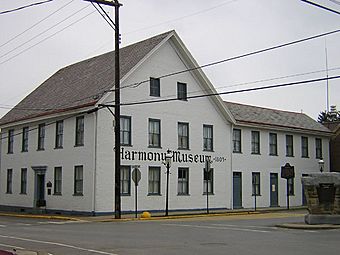Harmony Historic District facts for kids
|
Harmony Historic District
|
|

Harmony Society building in Harmony, Pennsylvania, built in 1809.
|
|
| Location | PA 68, Harmony, Pennsylvania |
|---|---|
| Area | 17 acres (6.9 ha) |
| Built | 1804 |
| Architect | George Rapp and Frederick Reichert Rapp |
| Architectural style | 19th Century German-American |
| NRHP reference No. | 73002139 |
Quick facts for kids Significant dates |
|
| Added to NRHP | March 21, 1973 |
| Designated NHLD | May 30, 1974 |
The Harmony Historic District is a special place in Harmony, Pennsylvania. It shows us where the Harmony Society, a unique group of people, first settled a long time ago. This happened in the early 1800s in what is now Butler County, Pennsylvania, USA. The district covers an area about two blocks wide. It stretches north from German Road to Conoquenessing Creek, between Liberty and Wood Streets. Many buildings from the original settlement period are still standing here. Because of its important history, this area was named a National Historic Landmark District in 1974.
Contents
The Harmony Society's Journey
The Harmony Society was started in 1785 by Johann Georg Rapp in what is now Germany. Rapp and his followers faced challenges from the main church there. So, they decided to move to North America to find a new home.
Finding a New Home
In 1805, Rapp and about 200 families bought land in Butler County, Pennsylvania. Here, they founded the town of Harmony. This community was a "utopian community." This means they tried to create a perfect society where everyone worked together. They shared everything and lived by their religious beliefs. George Rapp was their main leader.
Growth and New Settlements
The Harmonist community was very successful. By 1814, about 700 people lived in Harmony. George Rapp's son, Frederick, then started a new settlement. This new place was in the Indiana Territory, which is now New Harmony, Indiana.
Later, in 1825, the Harmonists moved back to Pennsylvania. They settled in a new town called Economy. The Harmony Society continued as an organization until 1905.
Buildings and History in Harmony
Today, you can still see parts of the early Harmonist settlement in Harmony. The modern town still has the original street layout. Many brick buildings from that time are also still standing.
Important Buildings to See
The Harmony Historic District includes ten important buildings and one special site. Some of the main buildings are:
- The George Rapp House
- The Great House, also known as the Bentle Building (built around 1811)
- The Langenbacher House (built around 1805)
- The Harmonist Church (built in 1808)
- The "Stohr"
- The Beam Hotel
- The Frederick Rapp House
- The Schmitt House
- The Jacob Neff House (built around 1807)
- The Schreiber House
- The Wagner House
- The Mueller House
The Harmonist Cemetery
The original Harmonist Cemetery is also part of the district. It is the burial place for about 100 early Harmonists. Their graves do not have names or markers.
More to Explore



